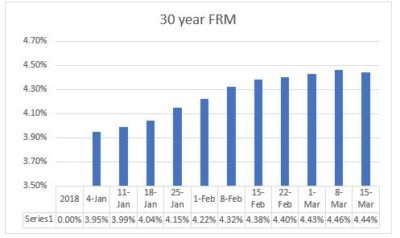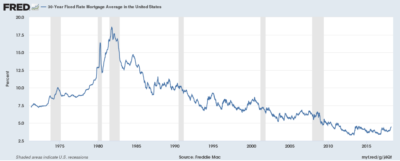Mortgage Rates: Relative versus Absolute
When my daughter was growing up I tried to impress on her the importance of understanding the difference between relative and absolute. Here’s an example: the forecast for next week’s snowstorm (as of Friday) was for 7 inches of snow. On a relative basis, after about 15 inches this week, that will be much better. But on an absolute basis it will still be a pain.
My attention was grabbed by an email I received yesterday with the headline: “Mortgage rates hit 5 week low.” Ignoring the fact that I can’t actually find the source for the claim (I am sure it exists) let’s look at the rate that I use most often in my articles about mortgage rates: the Freddie Mac weekly survey. Here’s a chart of the weekly rate this year:

Freddie Mac weekly survey
While a different source may have different actual numbers, it is pretty obvious that, while rates may be relatively lower this week, in absolute terms they are still about 0.5% higher than they were at the start of the year.
Mortgage rates, closely following the yield on the US 10 year Treasury as they do, often move quite sharply – up or down – over a short period of time. And whenever this move is upward a number of commentators, relishing their 15 minutes of fame, rush out statements claiming that the increased rate will have a negative impact on housing prices as homes become less affordable.
There are many factors in the decision to buy a home (rising income and optimism about the future are two that seem to get less attention than mortgage rates), but let me show a chart showing the history of the FRM for the last 40 years. The chart is not very clear when reproduced, but the message is that it is only in recent years that mortgage rates have dropped below 5%.

A year ago the FRM was 4.3%, which happened to be the highest rate for the year. And a year ago the yield on 10T was 2.6%, also the highest rate for the year. Several commentators have forecast this week that the yield on 10T may have peaked for this year when it reached 2.94% in February.
In my recent article What will happen to Home Prices in the Experimental Economy? I wrote: “Whether or not inflation does increase beyond the Fed’s 2% target, there is going to be a major increase in the amount of Treasuries that need to be sold this year to finance the sharply increased budget deficit. And this will occur when the Fed has switched from being a buyer of Treasuries to a seller, and when the projected weakness of the dollar makes buying anything in the US less attractive to foreign investors. If the supply increases and demand decreases, then prices should go down – which in bond markets means higher interest rates.”
Commentators suggest some of this effect may have been behind the recent rise in yields.
But enough. I hope this article and the others to which there are links give some perspective on recent moves in mortgage rates – which in absolute terms remain attractive.
If you – or somebody you know – are considering buying or selling a home and have questions about the market and/or current home prices, please contact Andrew Oliver on 617.834.8205 or Kathleen Murphy on 603.498.6817.
If you are looking to buy, we will contact you immediately when a house that meets your needs is available. In this market you need to have somebody looking after your interests.
Are you thinking about selling? Read Which broker should I choose to sell my house?
Andrew Oliver and Kathleen Murphy are Realtors with Harborside Sotheby’s International Realty. Each Office Is Independently Owned and Operated
@OliverReports
